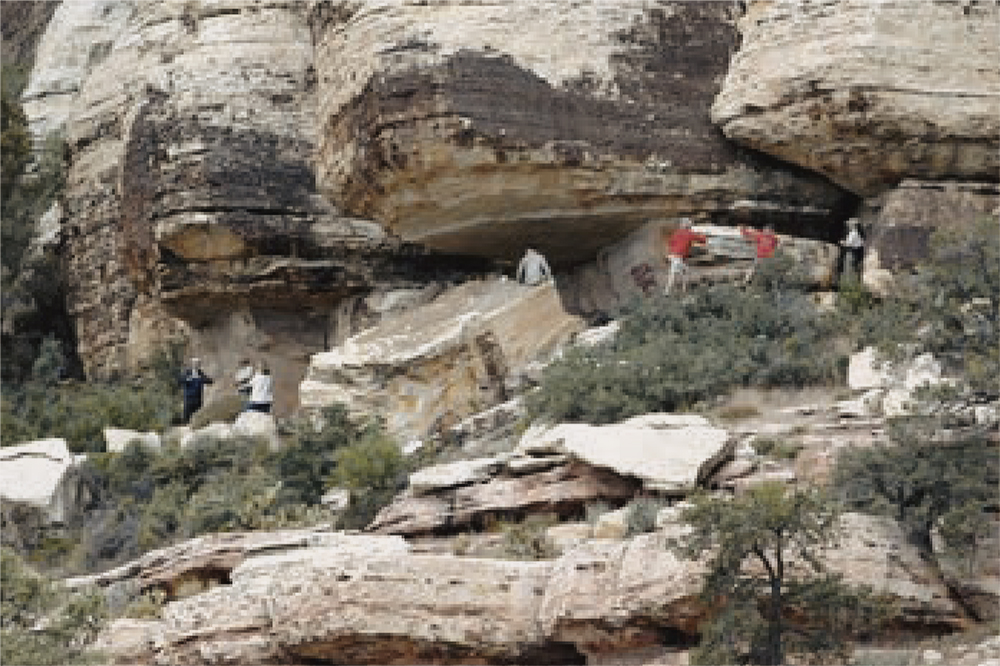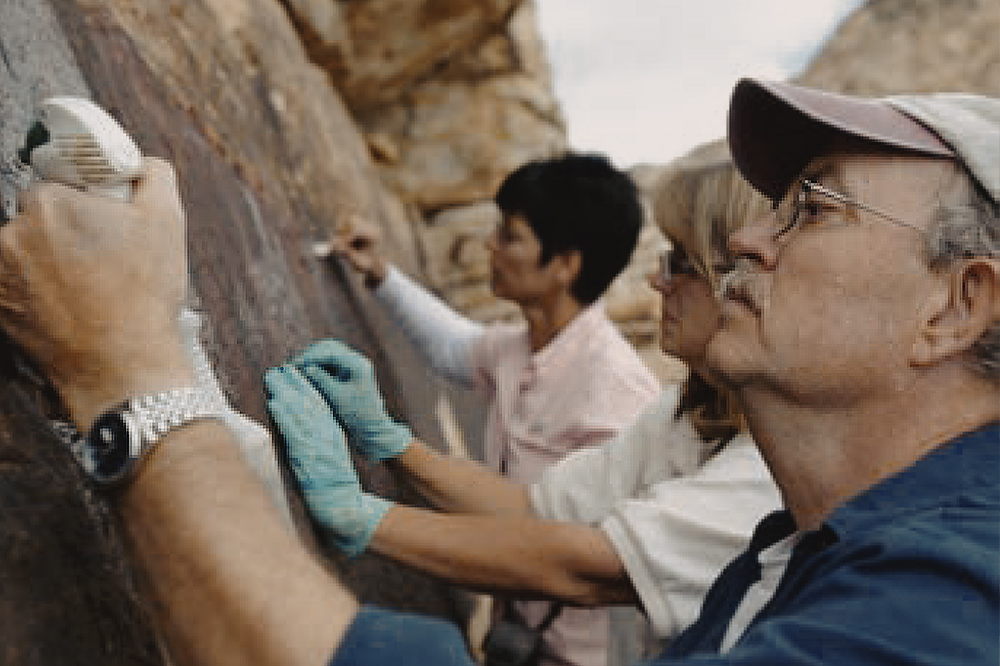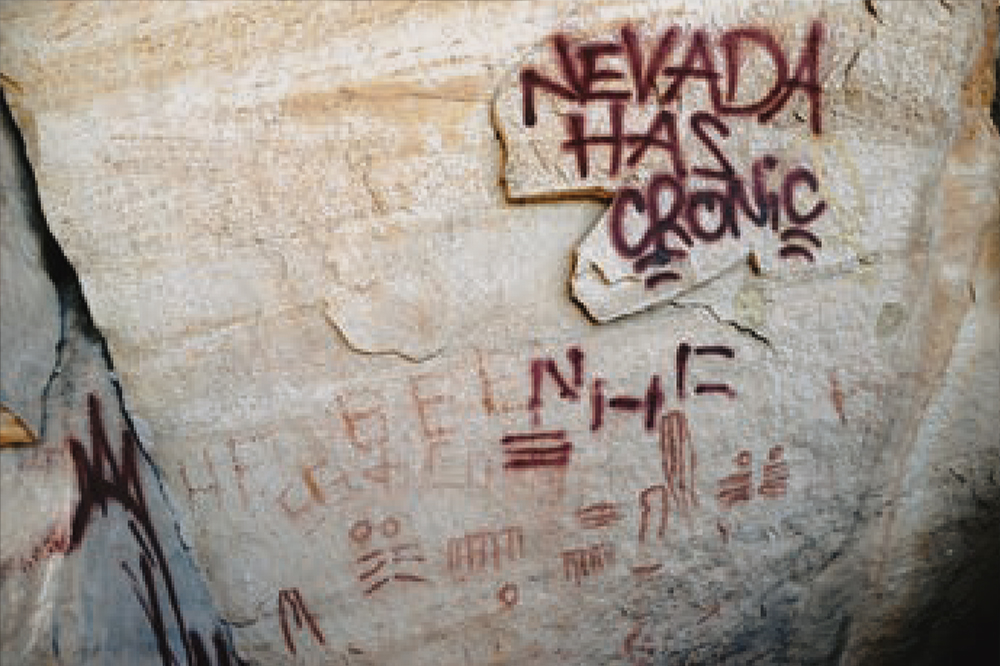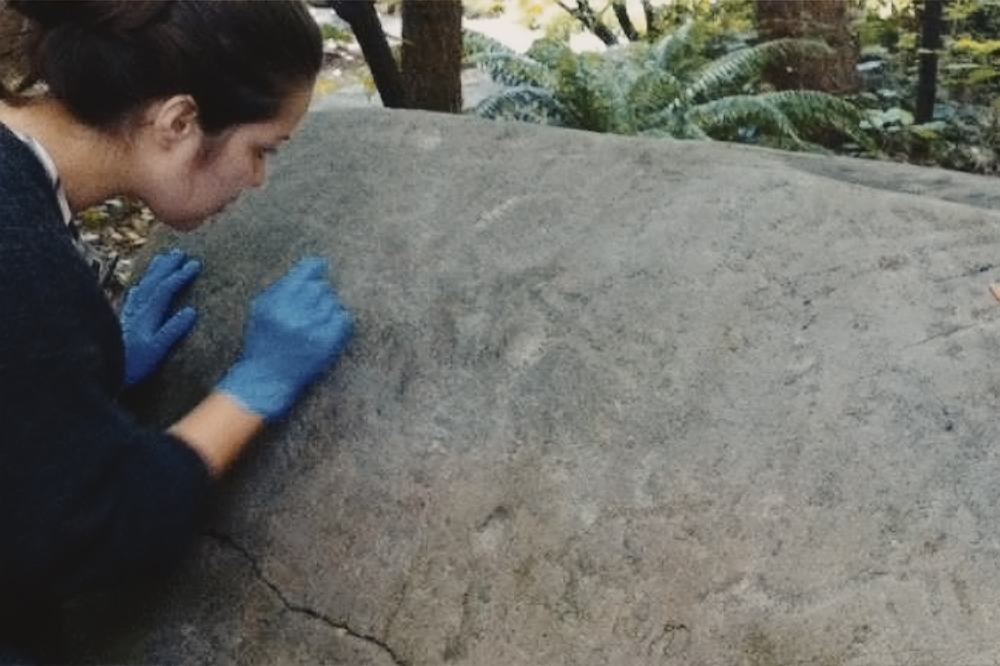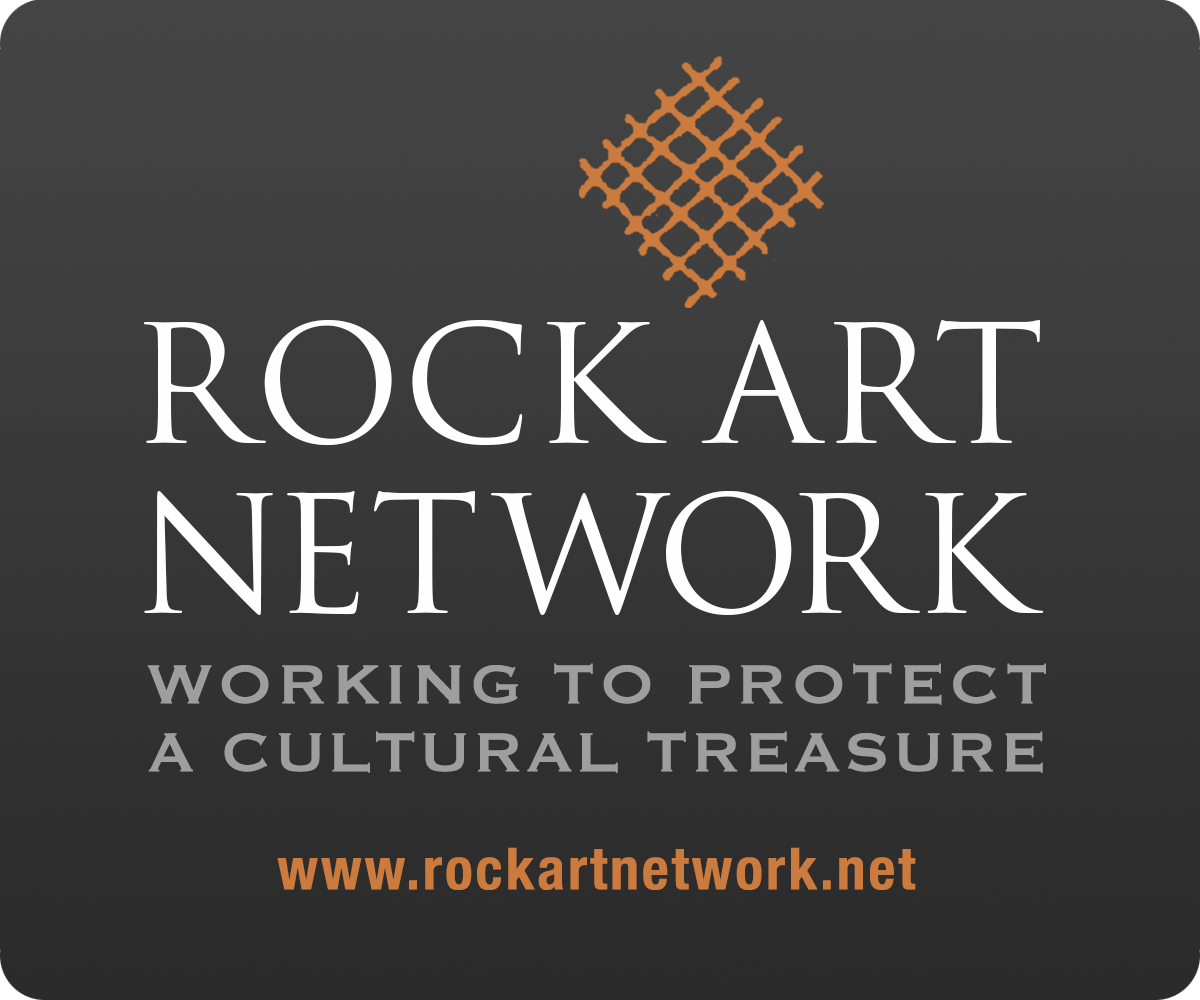
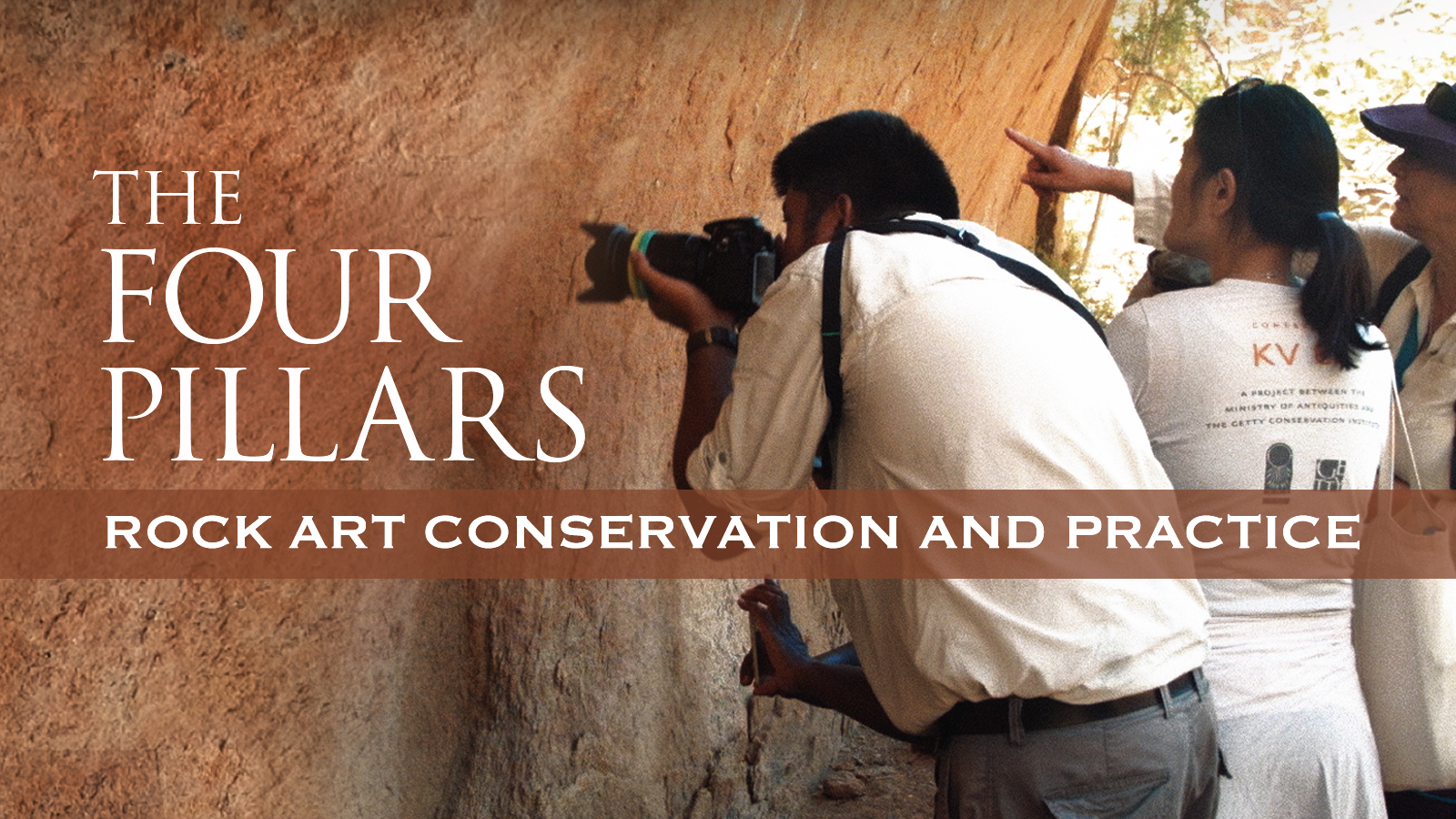
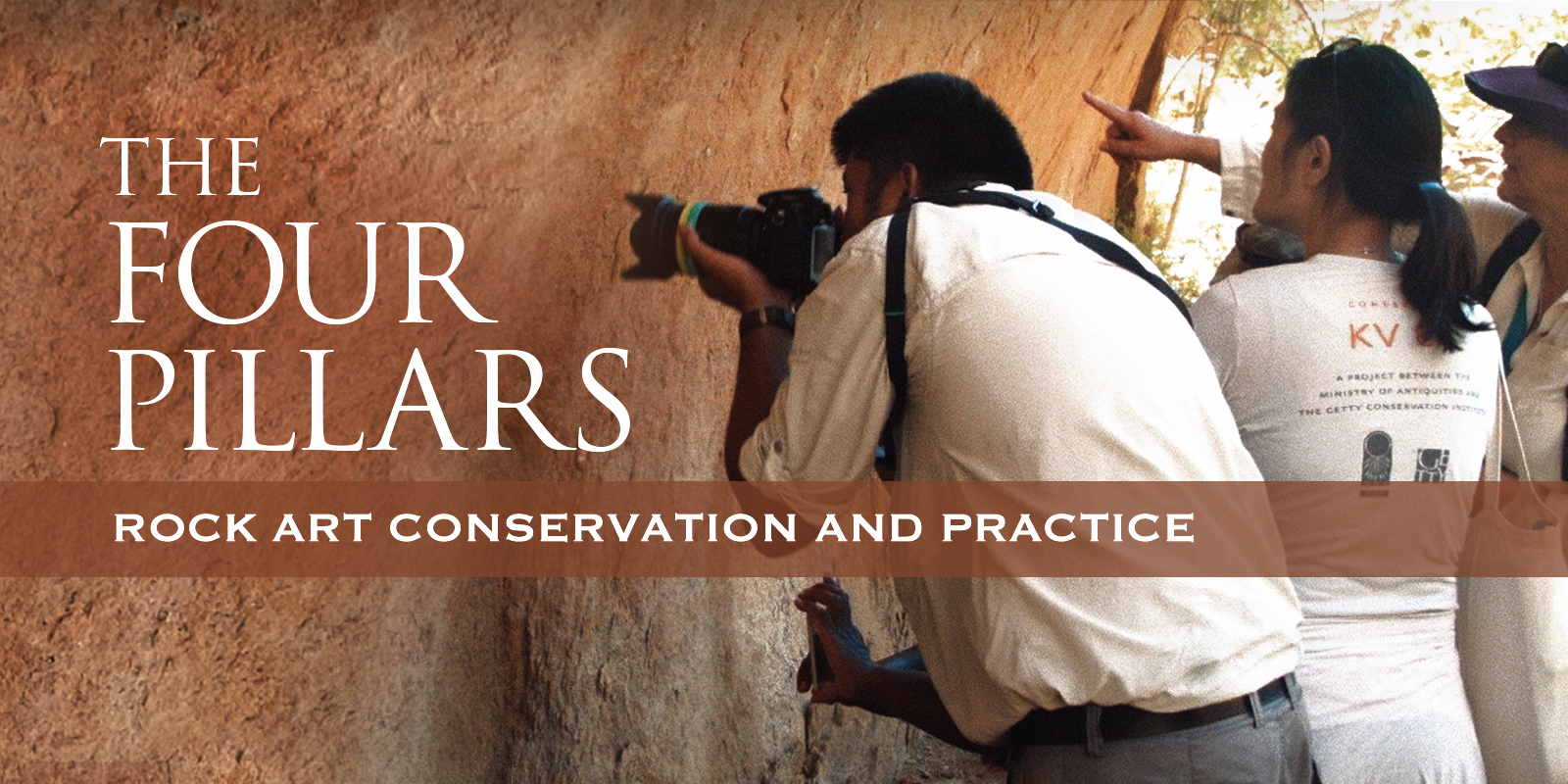
The Rock Art Network four ‘pillars’ make for strong rock art conservation in practice. This section sets out these four important areas of practice, citing a vision for what each aims to achieve, a summary of the key issues for each, a set of principles to guide practice at a more specific level and an outline of what needs to be done to improve policy and practice.
This pillar of rock art conservation covers the detailed work undertaken at and for rock art sites to ensure their physical protection and, if necessary, conservation. It also covers the cultural practices that secure the physical and spiritual integrity of rock art sites. An important aspect of this pillar is to emphasise that physical conservation and cultural conservation need to be considered, planned and undertaken in dialogue with each other. In each case, it is important that people with suitable expertise are available, that expert knowledge (cultural and scientific) is respected and that informed decisions are made regarding the physical and cultural benefits and impacts of actions. A record of all interventions is necessary and must be kept for future reference.
The vision is to have:
- Rock art conservation protocols and practices available to support the custodial roles of traditional owners, local communities and responsible management agencies to look after rock art sites;
- People suitably trained in technical aspects of rock art conservation who have a knowledge of international standards and practices;
- A system whereby technical advice and support can be effectively accessed by those responsible for sites;
- The capacity to enable quick and effective response to urgent conservation threats, vandalism and natural disasters; and
- Ongoing research into rock art conservation issues and techniques which can inform future practice.
A range of issues and concerns are impeding the conservation practice that applies to rock art:
- There has in the past been a focus on simple or 'quick fix' methods for protecting rock art, however practice has shown that conservation treatments such as chemical consolidation, protective screens and other highly invasive measures can lead to greater impact on sites than if they had been left alone. Sometimes in the past, not enough attention has been given to preventive conservation measures and the careful consideration and analysis of options as a first step prior to decisions being made on conservation actions that may make a permanent change at sites;
- There is a lack of formal training in rock art conservation and of trained conservators with experience in rock art conservation to assist traditional owners, local communities and management agencies;
- Lack of access to expertise and advice on technical aspects of rock art conservation has led to poor practice which affects the integrity and research potential of sites. This includes use of inappropriate materials and methods which causes lasting damage to sites. People have been unaware that contamination from consolidation chemicals and solvents used in cleaning and graffiti removal may make future dating unreliable or impossible;
It can be difficult for young conservators and other specialists to gain adequate and sustained experience in technical aspects of rock art conservation. Mentoring and apprentice arrangements are not as available as they are in other areas of materials conservation and archaeology for example;
- There are few opportunities for people with training and experience in technical aspects of rock art conservation around the world to meet and develop stronger networks to help develop and promote better practice;
- There is a lack of clear documentation protocols and standards that can enable conservation treatments to be monitored over time and to assist in evaluating the long-term effects of conservation actions;
- Research into rock art conservation methods remains sporadic and lacks a long-term strategic focus to assist rock art conservation practice to advance in a logical, constructive progression;
- There is a lack of clear procedures to assist in the protection of rock art sites under threat in emergency situations, including flooding, fire, earthquake, war;
- In some cases, the economic or cultural practices of local communities can cause impacts on rock art sites. These impacts may result from a lack of awareness about the effects they are having on the condition of rock art. Dialogue about conservation is needed to help resolve complicated issues of local custom in this regard; and
- In general, there is a lack of peer-review processes for rock art conservation proposals and treatment programs. This is in part due to the lack of structures for networking and communication between conservation professionals and the lack of suitably qualified rock art conservators.
The following principles should be used to guide conservation practice at rock art sites:
Respect cultural practices
Conservation approaches respect local cultural forms of conservation practice and create dialogue about conservation options to support the roles of site custodians. Maintaining, facilitating and celebrating stories, songs, dance, ceremonies and other cultural practices may be an essential part of conservation.
Utilize knowledge
Rock art conservation should utilise all the knowledge available to help make decisions about the future of sites.
Involve custodians
Proposals for conservation work, conservation treatments and their evaluation and review should fundamentally involve site custodians to ensure conservation is planned correctly, is consistent with the values of the site/s and that conservation works are implemented, monitored, recorded and reviewed considering custodial perspectives.
Recognize expertise
The expertise required to undertake conservation work should be recognized at an individual, group and organizational level. The conservation conditions at sites can be extremely complex and people with suitable training, experience and expertise should be utilized to assess sites and undertake treatments according to established international conservation standards.
Recognize that different levels of complexity need different levels of practice
Training in rock art conservation practices should involve a recognition of skills and knowledge levels for various levels of complexity of work. Training for people to undertake site monitoring and maintenance activity should be distinguished from the technical skills of approaches which require knowledge of materials science and an ability to understand the complex physical macro and micro processes operating at rock art sites. All training should include an emphasis on recognizing limits of skills and the need to seek suitable expertise to assist where the required skills are not available locally. Training programs should be designed according to recognized best practice with reference to international standards and practices.
Ensure skilled and sufficient human resources
All rock art conservation programs need to have a specific position responsible for overseeing the implementation of programs and providing necessary reports on progress to traditional owners, local communities and organization decision-makers. All rock art programs should have some means of gaining access to advice and expertise if required. Networks of professional support, reference groups and peer review of conservation approaches are an important part of best practice conservation approaches. Attracting further support for funding greater human resources necessary for conservation programs will always be a challenge. Clearly establishing the values of a body of rock art and summarizing the threats it faces helps to build a case for the human resources that are required to support conservation programs.
Recognize the appropriate conservation context
Rock art is not isolated in time or space. Rock art is an inherent part of the landscape in which it is found and conservation practice needs to recognize its setting within a contemporary cultural landscape. Rock art conservation should be planned and undertaken as part of and within a broader conservation plan, management plan or strategy.
Begin with a condition assessment and analysis
Conservation practice should include an observation and assessment of the condition of sites, an analysis of the impacts and the associated processes involved and a summary of the threats to the values.
When in doubt, leave it alone
Rock art may have existed in its environmental context for hundreds or thousands of years. The micro-environmental conditions of natural rock surfaces can be very complex. Unless there is a comprehensive understanding of the materials, agents and processes involved in rock art deterioration or damage it is preferable to not interfere. Misguided and unskilled conservation efforts can cause more harm than good. Sometimes it is best to do nothing.
Take a cautious approach
Rock art conservation should endeavor to do 'as much as necessary, but as little as possible' in line with recognized conservation guidelines such as The Burra Charter of Australia ICOMOS. This applies to any physical conservation work, but it is also an important principle for all activities. Approaches and projects which are cautious, simple and specific to a problem that has been identified are likely to be the most effective and sustainable.
Ensure documentation and archiving
All aspects of rock art conservation need to be well documented to ensure suitable records are available for the future. All conservation actions should be documented before, during and after works are undertaken. Records of conservation actions should be included in a report and incorporated into archival record keeping systems to ensure they are accessible in the future.
Make monitoring a rule
Conservation actions themselves need to be monitored in order to assess their effectiveness. Simple methods of monitoring what is done should be established when planning and undertaking conservation work.
Graffiti removal (above): In Red Rock Canyon in Nevada in November 2010, panels with rock art estimated to be up to 1,000 years old were sprayed with graf ti. Funds for the graf ti removal were raised by the Red Rock Canyon Interpretive Association, the Friends of Red Rock Canyon and the Bureau of Land Management. The removal was undertaken in May 2011 by Jannie Loubser, a trained rock art conservator. Graffiti removal can be a complex conservation process and should only be attempted by quali ed or highly experienced practitioners. In August 2011, a 17-year-old youth was tracked down, arrested and charged over the Red Rock Canyon incident, receiving a sentence of nine months in jail and an order to pay $23,775 in restitution for the cost of the graffiti removal.
Painstaking work (above): Conservation work being undertaken on a petroglyph panel by conservators from the Vancouver Museum. This panel from the Fraser River in British Columbia, Canada, was suffering from overgrowth of mosses and lichen and the work was undertaken in cooperation with Stswecem'c Xgat'tem First Nation elders. Cleaning of both painted and engraved rock art panels is usually technically possible, but there needs to be careful assessment of the cultural and technical merits of such conservation work to establish whether such treatment is an appropriate option.
Preventive conservation (above): It is important to undertake basic maintenance programs at important sites as a form of preventive conservation. Indigenous heritage of cers, rangers and local community members can be trained to carefully undertake minimal impact maintenance activities, such as reducing vegetation that is a re risk. In this photo, Brian Blurton from the Western Australian Museum is carefully removing mud nests from birds that were threatening to extend over the rock art panels. Experience has shown that removing some nests, but not all is enough to deter the incremental expansion of bird nests. It is important in any maintenance activity that people are trained to be aware of the limits of their expertise.
Trained rock art conservators (above): In this photo, Claire Dean from the USA cleans an accumulation of avian guano over a painting at Hunters Cave in South Africa. There is a lack of trained conservation professionals with experience in the unique environmental conditions and technical issues of rock art.
Training
1. Develop a standard curriculum framework to be shared internationally covering:
- The role of values and cultural practices in rock art conservation;
- Fundamentals of rock weathering;
- Condition assessment and methods of recording of conservation impacts and processes;
- Integrated conservation strategies and sustainable implementation programs;
- Site monitoring methods;
- Site maintenance practices for application by field staff;
- Graffiti recording, removal and emergency response strategies;
- Advanced conservation treatment methods, approaches and practices; and
- Documentation and data management for rock art conservation programs.
2. Use the standardized curriculum framework to develop locally appropriate training modules and hold training courses which encourage regional, national and international participation to promote broader learning, exchange and application of rock art conservation techniques.
3. Develop rock art conservation training modules which are designed for incorporation into other professional or workplace training programs for archaeologists, heritage practitioners, natural resource management and other relevant sectors.
Provide mentoring opportunities
4. It can be difficult to gain direct experience in applied rock art conservation techniques. In undertaking conservation works and programs, effort should be made to facilitate mentoring opportunities for younger people to learn one-on-one from experienced rock art conservation practitioners during actual work programs. Where possible, interregional and international opportunities for mentoring should be encouraged.
Prioritize preventive conservation
5. Passing on to younger generations the knowledge of how to care for rock art sites is of fundamental importance to sustainable conservation and cultural processes. Traditional methods of cultural transmission should be encouraged through active programs of caring for local sites by children and youth under the supervision of local custodians.
6. Specific education programs should be developed in local communities living close to rock art sites. This is especially necessary where graffiti or site damage by local children has been a problem. Schools programs and junior ranger programs in protected areas can include specific components on rock art sites and their conservation. Rock art sites are powerful tools for education and children can also contribute to rock art conservation programs. Develop conservation research programs and ensure the sharing of knowledge about rock art conservation issues, practices and techniques.
7. Create a web resource for rock art conservation publications and reports as a support for practice and to build a searchable online library of free materials on specific rock art conservation topics.
8. Establish national points of contact for rock art conservation to assist traditional owners, local communities and responsible organizations to find suitable expertise and information.
9. Create reference groups and supportive peer review systems for rock art conservation programs.
10. Support meetings of trained and experienced rock art conservators to assess achievements in rock art conservation techniques, identify research gaps and address future priorities and opportunities for research and collaboration.
11. Develop an international collective perspective on technical aspects of rock art conservation and priorities requiring research attention through international collaboration and support from organizations with an interest in rock art conservation.
12. Target aspects of conservation practice that lack a suitable research base, for example better understanding of the motivation for graffiti/defacement and the effectiveness of management responses.
13. Promote key demonstration sites or projects which clearly illustrate to others how cross-disciplinary research perspectives can assist in addressing challenges facing rock art conservation practice, including across physical and social sciences and traditional knowledge in partnership with Indigenous people and local communities.
Mobilize and organise human resources for rock art conservation
14. To build skills and create greater effectiveness, regional and national rock art work teams should be established to enable support to be delivered to traditional owners, local communities and shared between organizations and responsible agencies. If at all possible, teams should be constituted in such a way that they can be used for rapid response if required.
15. Develop mechanisms that facilitate appropriate volunteer involvement and professional pro-bono contributions to rock art conservation programs to maximize effectiveness where suitable funds are limited or non-existent.
→ Members and affiliated institutions of the Rock Art Network
by
George Nash
5/09/2024 Recent Articles
→ Sigubudu: Paintings of people with guns in the northern uKhahlamba-Drakensberg
by Aron Mazel
22/07/2024
by Richard Kuba
13/06/2024
by Meenakshi Dubey-Pathak
8/03/2024
by Rock Art Network
6/02/2024
by Rock Art Network
14/12/2023
by Sam Challis
5/12/2023
by Aron Mazel
30/11/2023
by Sam Challis
21/11/2023
by Sam Challis
15/11/2023
by Sam Challis
10/11/2023
by Rock Art Network
6/11/2023
by Rock Art Network
3/11/2023
by Aron Mazel
2/11/2023
by Meenakshi Dubey-Pathak
26/09/2023
by Paul Taçon
24/08/2023
by Aron Mazel
13/06/2023
by Paul Taçon
5/06/2023
by Paul Taçon
15/03/2023
by George Nash
14/03/2023
by Noel Hidalgo Tan
10/02/2023
by George Nash
01/02/2023
by Meenakshi Dubey-Pathak, Pilar Fatás Monforte
29/11/2022
by Aron Mazel, George Nash
21/09/2022
by Paul S.C. Taçon, Sally K. May, Ursula K. Frederick, Jo McDonald
07/07/2022
by Meenakshi Dubey-Pathak
26/07/2022
by Paul Taçon
20/07/2022
by David Coulson
16 June 2022
by Paul Taçon
25 April 2022
by Noel Hidalgo Tan
20 April 2022
by Meenakshi Dubey-Pathak
14 March 2022
by Carolyn Boyd & Pilar Fatás
02 March 2022
by David Coulson
07 February 2022
by Johannes H. N. Loubser
06 February 2022
by Meenakshi Dubey-Pathak
05 February 2022
by Aron Mazel
28 January 2022
by Aron Mazel
8 September 2021
by David Coulson
17 August 2021
by Ffion Reynolds
21 June 2021

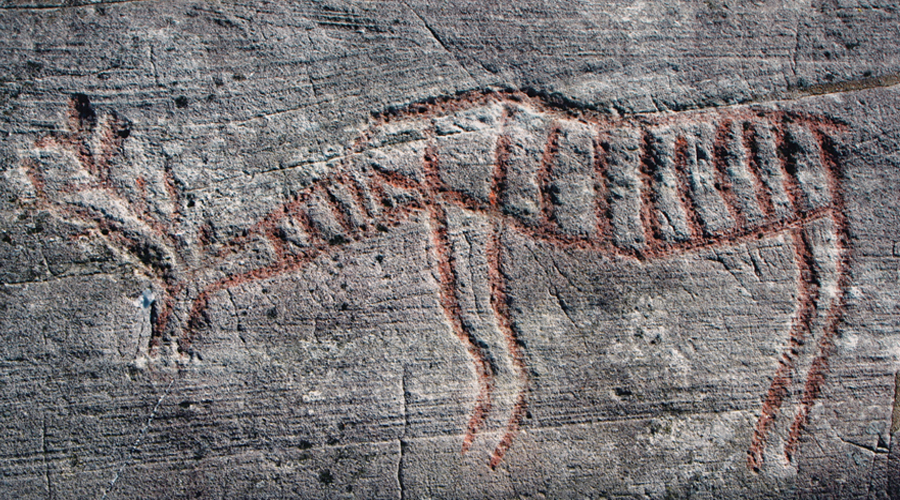
by Aron Mazel
22/07/2024
by Richard Kuba
13/06/2024
by Meenakshi Dubey-Pathak
8/03/2024
by Rock Art Network
6/02/2024
by Rock Art Network
14/12/2023
by Sam Challis
5/12/2023
by Aron Mazel
30/11/2023
by Sam Challis
21/11/2023
by Sam Challis
15/11/2023
by Sam Challis
10/11/2023
by Rock Art Network
6/11/2023
by Rock Art Network
3/11/2023
by Aron Mazel
2/11/2023
by Meenakshi Dubey-Pathak
26/09/2023
by Paul Taçon
24/08/2023
by Aron Mazel
13/06/2023
by Paul Taçon
5/06/2023
by Paul Taçon
15/03/2023
by George Nash
14/03/2023
by Noel Hidalgo Tan
10/02/2023
by George Nash
01/02/2023
by Meenakshi Dubey-Pathak, Pilar Fatás Monforte
29/11/2022
by Aron Mazel, George Nash
21/09/2022
by Paul S.C. Taçon, Sally K. May, Ursula K. Frederick, Jo McDonald
07/07/2022
by Meenakshi Dubey-Pathak
26/07/2022
by Paul Taçon
20/07/2022
by David Coulson
16 June 2022
by Paul Taçon
25 April 2022
by Noel Hidalgo Tan
20 April 2022
by Meenakshi Dubey-Pathak
14 March 2022
by Carolyn Boyd & Pilar Fatás
02 March 2022
by David Coulson
07 February 2022
by Johannes H. N. Loubser
06 February 2022
by Meenakshi Dubey-Pathak
05 February 2022
by Aron Mazel
28 January 2022
by Aron Mazel
8 September 2021
by David Coulson
17 August 2021
by Ffion Reynolds
21 June 2021
Friend of the Foundation


by Aron Mazel
22/07/2024
by Richard Kuba
13/06/2024
by Meenakshi Dubey-Pathak
8/03/2024
by Rock Art Network
6/02/2024
by Rock Art Network
14/12/2023
by Sam Challis
5/12/2023
by Aron Mazel
30/11/2023
by Sam Challis
21/11/2023
by Sam Challis
15/11/2023
by Sam Challis
10/11/2023
by Rock Art Network
6/11/2023
by Rock Art Network
3/11/2023
by Aron Mazel
2/11/2023
by Meenakshi Dubey-Pathak
26/09/2023
by Paul Taçon
24/08/2023
by Aron Mazel
13/06/2023
by Paul Taçon
5/06/2023
by Paul Taçon
15/03/2023
by George Nash
14/03/2023
by Noel Hidalgo Tan
10/02/2023
by George Nash
01/02/2023
by Meenakshi Dubey-Pathak, Pilar Fatás Monforte
29/11/2022
by Aron Mazel, George Nash
21/09/2022
by Paul S.C. Taçon, Sally K. May, Ursula K. Frederick, Jo McDonald
07/07/2022
by Meenakshi Dubey-Pathak
26/07/2022
by Paul Taçon
20/07/2022
by David Coulson
16 June 2022
by Paul Taçon
25 April 2022
by Noel Hidalgo Tan
20 April 2022
by Meenakshi Dubey-Pathak
14 March 2022
by Carolyn Boyd & Pilar Fatás
02 March 2022
by David Coulson
07 February 2022
by Johannes H. N. Loubser
06 February 2022
by Meenakshi Dubey-Pathak
05 February 2022
by Aron Mazel
28 January 2022
by Aron Mazel
8 September 2021
by David Coulson
17 August 2021
by Ffion Reynolds
21 June 2021
Friend of the Foundation
